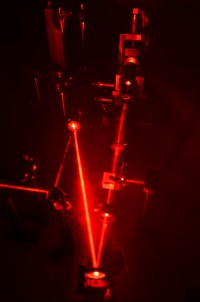Phonons get stuck in the hunt for metallic hydrogen

A combination of theory and experiment by researchers in the School's Centre for Science at Extreme Conditions (CSEC) has revealed surprising behaviour in high-pressure dense hydrogen-deterium mixtures. Reported this week as Editor's Choice in the prestigious "Physical Review Letters”, the study shows that the concept of a phonon loses its meaning when isotopes have very different masses.
The great unsolved challenge of high pressure physics is to metallize hydrogen. The giant magnetic fields of Jupiter and Saturn prove the existence of such a material, but it has never been synthesized on Earth or studied at low temperature. The School's Ross Howie and Eugene Gregoryanz, and Alex Goncharov from the Carnegie Institution squeezed tiny amounts of solid hydrogen/deuterium mixtures between diamond anvils, to create some of the highest static pressures ever achieved on Earth. (Their unique experimental set-up in the CSEC laboratories in Edinburgh is shown in the figure.)
However, this means that with the mixtures the Raman signal is three times weaker per mode than in pure isotope and that only by using the state-of-the-art red Raman system provided by the School of Physics was it possible to build the apparatus and conduct these technically-demanding experiments.
Some information about the state of the material was extracted by Raman spectroscopy. Detailed theoretical analysis of the material by Ioan Magdau and Graeme Ackland using EPCC's supercomputers shows that the Raman signal corresponds to a phenomenon known as "Anderson Localization", in which vibrations are unable to propagate through the material. The cause of the localization is the disorder of the hydrogen and deuterium atoms in the structure, which scatters travelling waves.
A further consequence is that all vibrations in the crystal have some Raman scattering effect, compared with the normal case where only a handful of so-called "Gamma-modes" contribute to the observable effect.
But is it metallic? A 2011 report by a group from Mainz claimed in a Nature paper that pure hydrogen was indeed conductive at these pressures. Their evidence was equivocal, but our samples show no sign of metallic behaviour (see papers in Physical Review Letters and Physical Review B), and our calculations suggest there should be a sizable band gap regardless of the isotopic composition. The Germans are debunked and the hunt for metallic hydrogen goes on.
"Phonon localization by mass disorder in dense hydrogen-deuterium binary alloy" Ross T. Howie, Ioan B. Magdău, Alexander F. Goncharov, Graeme J. Ackland, and Eugene Gregoryanz: Phys. Rev. Lett. 113, 175501 (published 21 October 2014).

